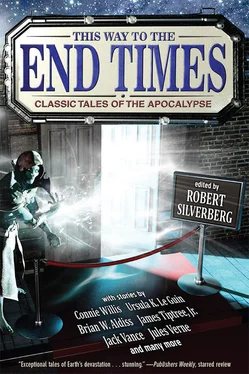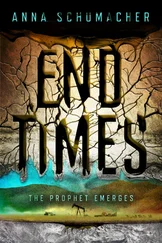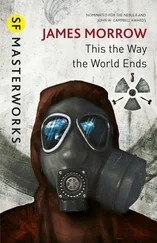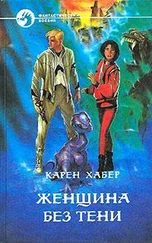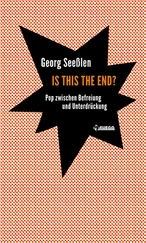“The Eternal Adam,” however, one of the last works of Verne’s old age, is science fiction beyond doubt, and a masterpiece of the genre. So far as we know he began writing it in 1904, when he was seventy-six years old and in failing health, troubled by cataracts, diabetes, and the lingering effects of a bullet wound received at the hand of a crazed nephew. Whether he actually lived to complete it is a matter of extensive debate among Verne scholars. At one point he had told his Parisian publisher that he was working on a story called “In Two Thousand Years’ Time,” but no manuscript under that title survives, and “The Eternal Adam” is actually set 20,000 years in the future, not 2,000. When Verne died, on March 24, 1905, at the age of seventy-seven, he left behind a stack of unpublished novels, some of them incomplete, some of them not, and a handful of short stories. Over the next few years his son Michel, a considerable writer in his own right, saw most of this material into print, and from an examination of Verne’s original manuscripts it is possible to see that Michel rewrote a good deal of his father’s work and may have done nearly the entire texts of some of the posthumous books.
“The Eternal Adam” saw its first publication in October 1910 in a magazine called La Revue de Paris, and then later that year as part of a collection of stories entitled Yesterday and Tomorrow. Verne wrote very few short stories; only one collection appeared in his lifetime, Dr. Ox’s Experiment of 1874, and a handful of others were used as fillers to accompany various of his novels. Two of the six stories in Yesterday and Tomorrow are surely by Verne, but the other four, including “The Eternal Adam” were part of the group of unpublished manuscripts he left behind at his death, and, as noted, no one is quite sure how much of them was written by Verne and how much by his son under his father’s far more illustrious name. The eerie and deeply moving “Eternal Adam,” in which archaeologists from a civilization of the far future discover a chronicle of the destruction of the twentieth-century world by earthquakes and floods, is so dark in tone that Michel Verne, in his introductory note to it in Yesterday and Tomorrow, was constrained to point out its “rather pessimistic conclusions, contrary to the proud optimism that inspired the Extraordinary Voyages .” Yet the story, dark as it is, demonstrates true Vernian optimism after all, since mankind does manage to survive the terrible catastrophes he visits upon us, and emerges eventually from disaster to build a new civilization.
“The Eternal Adam” did not appear in English until it was translated by Willis T. Bradley more than forty years after its initial French publication. The Bradley translation was published in the March 1957 issue of an obscure and short-lived science-fiction magazine called Saturn, from which it is reprinted here.
—R. S.
THE ZARTOG SOFR-AI-SR—THAT IS, THE learned Doctor Sofr, youngest member of the hundred-and-first generation of his lineage—was making his way at a comfortable pace along the chief street in Basidra, capital of the Hars-Iten-Schu, the Empire (as we should call it) of the Four seas. These four seas, the Tubelone, or Northern, the Ehone, or Southern, the Spone, or Eastern, and the Merone, or Western, bounded the vast, irregularly shaped continent, the limits of which (to reckon in terms known to my reader) reached, in longitude, as far as the fortieth degree east and the seventieth degree west, and, in latitude, as far as the fifty-fourth parallel north and the fifty-fifth parallel south.
The extent of none of these seas could be guessed, even roughly, since each merged with each, and a navigator putting out from any one of the four coasts, and sailing always in a straight line, must gain the diametrically opposite coast. For, over the entire surface of the globe, save for one useless islet in the Merone-Schu, there existed no other land than that of the Hars-Iten-Schu.
Sofr was walking very slowly, first of all because the day was warm: they were entering the hot season, and at Basidra, situated on the shore of the Spone-Schu, or Eastern Sea, less than twenty degrees north of the equator, a fierce heat fell from the sun, then approaching its zenith.
But, even more than his weariness in that high heat, the very burden of his thoughts was slowing the steps of Sofr, the scholarly Zartog. While absent-mindedly mopping his forehead, he was turning over in his mind what had been said at the meeting that had just been held, during which so many gifted speakers (among whom, to his honor, he had himself numbered) had hailed the hundred-and-ninety-fifth year of the Empire.
Some, for topic, had chosen history, not only that of the Empire, but the entire history, indeed, of mankind. They had told again the story of the Mahart-Iten-Schu, the Land of the Four Seas originally divided among uncounted savage peoples who lived in wild loneliness, having almost no knowledge of each other. Back to those folk were traced the most ancient traditions. Of still earlier things, nothing was known. True, the natural sciences were now beginning to make out some light, hardly more than a feeble glimmer in the baffling darkness of those earlier times. But even so, by their very remoteness they shunned truly historical study. True history could first take root only in a dim memory of those scattered ancient clans.
During more than eight thousand years, by degrees more fully told and more sharp in detail, the story of the Mahart-Iten-Schu was nothing but a succession of strife and warfare, first between man and man, then between family and family, and finally between tribe and tribe—every living being, every group, small or large, having, in the course of the ages, no other goal than to prove its strength against its rivals, and striving, with diverse and often contrary success, to bring them under its own laws.
On this side of that span of eight thousand years, men’s memories became a little keener. At the outset of the second of the four periods into which the annals of the Mahart-Iten-Schu were commonly divided, legend began to deserve more justly the name of history. But still, whether history or legend, the recitals seldom varied: they told always of bloodshed and butchery—no longer, it is true, of tribe by tribe, but from then on of people by people. So, all in all, this second period was not much different from the first.
And it was much the same thing with the third, brought to a close just short of two hundred years ago, having lasted through nearly six centuries. It differed only in that it was more brutal, a period during which gathered into endless armies, and fired with endless fury, men had drenched the earth with their blood.
THE FACT WAS THAT A little less than eight centuries previous to the day when the Zartog Sofr was strolling along the chief street in Basidra, mankind had felt itself ripe for a vast and decisive effort. By that time, brute force having already fulfilled a part of its necessary task, and the weak having bent before the strong, the men of the Mahart-Iten-Schu formed three distinct and fairly matched nations, within each of which the passing of time had softened the differences between the winners and the losers of former days. It was about then that one of those nations had undertaken to subdue its neighbors. The men who dwelt in the middle of the Mahart-Iten-Schu, the Andarti-Ha-Sammgor, or Men with Bronze Faces, strove ruthlessly to enlarge their frontiers, within which their fiery and fertile people were being squeezed. In succession, and at the cost of hundred-year wars, they had conquered the Andarti-Mahart-Horis, the Men of the Snow Country, who lived in the land to the south, and the Andarti-Mitra-Psul, the Men of the Fixed Star, whose country lay to the north and west.
Читать дальше
